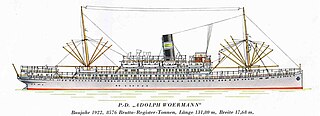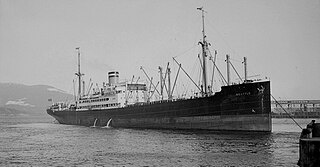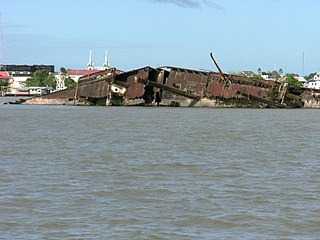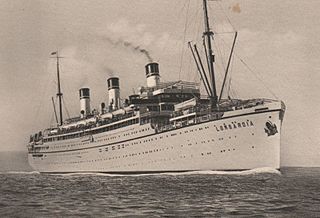
Tango Maru (丹後丸) was a cargo motor ship that was built in Germany in 1926 and sunk off the coast of Bali in 1944. She was launched as Rendsburg for the Deutsch-Australische Dampfschiffs-Gesellschaft (DADG), which in 1926 merged with Hamburg-Amerikanische Packetfahrt-Actien-Gesellschaft (HAPAG).
SS Cambridge was a refrigerated steam cargo liner that was built in Germany for the Hamburg America Line. She was launched in 1916 as Vogtland, but after the 1919 Treaty of Versailles the United Kingdom took her as war reparations and sold her to the Federal Steam Navigation Company, who renamed her Cambridge. She operated between Britain and Australasia until 1940, when a German mine sank her off the coast of Australia.

SS Antilla was a Hamburg America Line (HAPAG) cargo ship that was launched in 1939 and scuttled in 1940.

SS Adolph Woermann was a German steam ocean liner built in 1922 by Blohm & Voss in Hamburg for the shipping lines Woermann-Linie (WL) and German East Africa Line and named after German merchant, ship owner and politician Adolph Woermann, and the fourth ship of the same name.

SS Donau was a Norddeutscher Lloyd (NDL) refrigerated cargo steamship that was built in Germany in 1929 and sunk in occupied Norway in 1945. In the 1930s she sailed mostly between Bremen and the West Coast of the United States via the Panama Canal.
SS Assyrian was a cargo ship that was built in Hamburg for German owners in 1914, transferred to British owners in 1920 as war reparations and sunk by a U-boat in 1940. She was launched as MS Fritz, and when she changed owners in 1920 she was renamed MS Assyrian. She had been built as a motor ship but in 1925 she was converted to a steamship and became SS Assyrian.

Kulmerland was a Hamburg America Line (HAPAG) cargo liner that was launched in 1928. She worked HAPAG's route between Hamburg and the Far East until 1939. In the Second World War she was a supply ship for German auxiliary cruisers in the Pacific and Indian Oceans. In 1942 she became a successful blockade runner to German-occupied Europe. An Allied air raid on German-occupied France in 1943 put her out of action. German forces sank her as a blockship in 1944. She was raised in 1945 after the Liberation of France, and scrapped in 1950.

MV Spreewald was a Hamburg America Line (HAPAG) cargo motor ship that was launched in 1922 and sunk in a friendly fire incident in 1942. She was renamed Anubis in 1935, and reverted to her original name Spreewald in 1939.

USS General W. C. Gorgas (ID-1365) was a cargo liner that was launched in Germany in 1902 as Prinz Sigismund for the Hamburg America Line. In 1917 the USA seized her and renamed her General W. C. Gorgas. In 1945 she was transferred to the Soviet Union, which renamed her Mikhail Lomonosov. She was scrapped in March 1958.

USS General G. W. Goethals (ID-1443) was a German cargo liner that the United States seized during the First World War. She was launched in 1911 for the Hamburg America Line (HAPAG) as Grunewald. In 1917 the US seized her in Panama, and the Panama Canal Railway (PCR) operated her for the United States Shipping Board (USSB). In 1919 she spent six months in the United States Navy, in which she made three round trips to and from France to repatriate US troops. In 1920 the PRC bought her from the USSB. In 1925 the Black Star Line owned her. In 1926 the Munson Steamship Line bought her and renamed her Munorleans. She was scrapped in Scotland in 1937.

Wahehe was a 4,690 GRT cargo ship which was built in 1922 as Wadigo by Reiherstieg Schiffswerfte und Maschinenfabrik, Hamburg for Woermann Linie AG. She was converted to a refrigerated cargo liner in about 1934.

SS Rio de Janeiro was a German cargo steamship owned by the Hamburg Südamerikanische shipping company and registered in Hamburg. She was built as Santa Ines in 1914 and renamed Rio de Janeiro in 1921. Until World War II she carried passengers and freight between Germany and South America.

SS Empire Energy was a cargo steamship. She was built in Germany in 1923 as Grete for small German tramp shipping company. In 1934 the Italian shipping magnate Achille Lauro bought her and renamed her Gabbiano.
SS Aguila was a British steam passenger liner. She was built in Dundee in 1917 and was sunk by enemy action in the North Atlantic in 1941. She belonged to Yeoward Line, which carried passengers and fruit between Liverpool, Lisbon, Madeira and the Canary Islands.
HMS Teviot Bank was a Bank Line steamship that was built in England in 1938 as the cargo ship Teviotbank. In the Second World War she was a Royal Navy auxiliary minelayer. By 1956 a Panamanian company had bought her and renamed her Nella. She was scrapped in Italy in 1971.

MS Seattle was a Hamburg America Line (HAPAG) cargo liner that was launched in 1928. Her regular route was between Hamburg and Vancouver via the Panama Canal and the West Coast of the United States.

SS Santa Fé was a German refrigerated cargo steamship. She is now a Black Sea shipwreck and part of her cargo is of interest to marine archaeologists.

Goslar is a partly-submerged shipwreck in the Suriname River in Paramaribo, Suriname. It is the remains of a Norddeutscher Lloyd (NDL) steam turbine cargo ship that was built in 1929. When the Second World War began in 1939, she sought refuge in Surinam, which was then a Dutch colony. When Germany invaded the Netherlands in 1940, her crew scuttled her.

SS Lombardia was one of a pair of transatlantic steam ocean liners that were launched in 1914 in Germany for the Hamburg America Line (HAPAG), sold to a Dutch shipping line in 1916, and seized by the United States as World War I reparations in 1922. United American Lines (UAL) operated her until 1926, when HAPAG bought her back.















